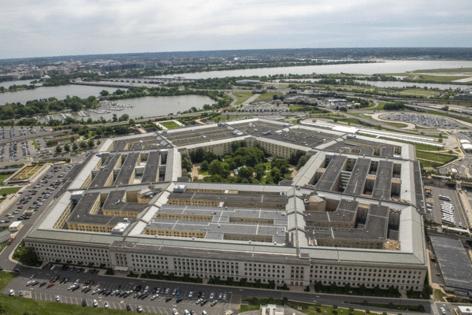Defense budget increase hinges on reconciliation success
Published in News & Features
WASHINGTON — The White House made official Friday that President Donald Trump wants the first ever $1 trillion defense budget.
Yet Trump will not be able to increase defense spending at all above current levels — in fact it would decrease after accounting for inflation — unless a narrowly divided Congress sends him a reconciliation bill containing a huge increase for defense in fiscal 2026, hardly a given.
White House officials unveiled on Friday morning a so-called “skinny” version of Trump’s fiscal 2026 federal budget request. More details are expected in the weeks ahead.
Hawks are already up in arms. Senate Armed Services Chairman Roger Wicker, R-Miss., issued a statement Friday criticizing the Office of Management and Budget, not Trump, for sending Congress what Wicker called an inadequate budget.
“The Big, Beautiful Reconciliation Bill was always meant to change fundamentally the direction of the Pentagon on programs like Golden Dome, border support, and unmanned capabilities — not to paper over OMB’s intent to shred to the bone our military capabilities and our support to service members,” Wicker said.
Likewise, Sen. Susan Collins, R-Maine, the chair of the Appropriations Committee, issued a statement expressing “serious objections to the proposed freeze in our defense funding given the security challenges we face.”
And Sen. Mitch McConnell, R-Ky., chairman of the Defense Appropriations Subcommittee, said Trump’s request “will double down on the Biden Administration’s material neglect” for security threats and, he said, “a one-time influx [of] reconciliation spending is not a substitute for full-year appropriations.”
The Trump administration believes increasing the defense budget via reconciliation is “a more durable way to get to $1 trillion in defense spending,” a senior official with the Office of Management and Budget told reporters Friday.
For national defense, the blueprint proposes $1.011 trillion in discretionary budget authority, of which 95% would be spent by the Pentagon.
That figure is 13.4% above the fiscal 2025 enacted level, administration documents show.
But the White House is hinging the entirety of that increase, or $119.3 billion, on enactment of the full amount of increase for defense contained in congressional Republicans’ reconciliation measure, which they hope will become law in several weeks.
Every budget proposal is contingent on congressional approval. But if the $150 billion in additional spending for defense that Republicans envision for the reconciliation bill does not come to pass, there will be no increase in defense in fiscal 2026, according to Trump’s proposal. The increase of $119.3 billion is the portion of the reconciliation package that the administration anticipates would be available in fiscal 2026.
Trump heralded the $1 trillion defense budget for fiscal 2026 last month.
“We’re going to be approving a budget, and I’m proud to say, actually, the biggest one we’ve ever done for the military,” Trump said. “$1 trillion. Nobody has seen anything like it.”
But it was not clear until Friday that the reconciliation proposal for defense would be a part of the record-setting budget, as opposed to a boost on top of it.
For the Defense Department, the fiscal 2026 budget proposal comprises $961.6 billion in discretionary budget authority.
That figure includes $848.3 billion in base funding and no nonbase funding such as so-called emergency spending. It also includes $113.3 billion that would come from a reconciliation bill.
“The Budget request for the Department of Defense builds on the President’s promise to achieve peace through strength by providing the resources to rebuild our military, re-establish deterrence, and revive the warrior ethos of our Armed Forces,” the OMB said in a statement. “In combination with $119 billion in mandatory funding, the Budget increases Defense spending by 13 percent, and prioritizes investments to strengthen the safety, security, and sovereignty of the homeland, deter Chinese aggression in the Indo-Pacific, and revitalize our defense industrial base.”
The president is asking for a 3.8% military pay raise, according to tables attached to a Friday letter from OMB Director Russell Vought to appropriators.
The nuclear weapons programs at the Energy Department’s National Nuclear Security Administration are also banking on reconciliation for all of their proposed increase in budget authority in fiscal 2026.
For that agency, the budget plan includes $24 billion, the same as the enacted fiscal 2025 amount, plus $6 billion that is contingent on enactment of the reconciliation bill’s proposed amount for the agency, the documents show.
As such, one fifth of the nuclear agency’s fiscal 2026 budget would hang on the success of the GOP reconciliation plan.
The State Department budget, meanwhile, would go down 84% from the current level under the Trump fiscal blueprint.
At the same time, the administration is proposing that nondefense spending go down 16.6% from the fiscal 2025 level.
________
(Roll Call's Paul M. Krawzak contributed to this report.)
________
©2025 CQ-Roll Call, Inc., All Rights Reserved. Visit cqrollcall.com. Distributed by Tribune Content Agency, LLC.







Comments